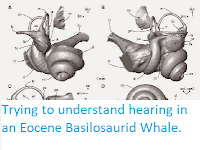The Vaquita, Phocoena sinus, is a small species of Porpoise found only in the northern part of the Gulf of California. Since the extinction of the Yangtze River Dolphin, Lipotes vexillifer, in 2006 it is considered to be the world's most endangered species of Cetacean, with a population of less than 30 in 2016. The species is particularly threatened by the illegal gillnet fishery for the Totoaba, Totoaba macdonaldi, a large species of Drum also considered to be Critically Endangered under the terms of the International Union for the Conservation of Nature’s Red List of Threatened Species. This industry has been illegal since 2015, with the Mexican government paying out around US$74 million to former fishermen in compensation, though this ban has had limited success, with the Mexican government, Sea Shepherd Conservation Society, Museo de la Ballena y Ciencias del Mar and WWF-Mexico reporting a total of 400 Totoaba gillnets confiscated in 2018.
A Vaquita Porpoise, Phocoena sinus, caught as by-catch in a gillnet in the Gulf of Mexico. Flip Nicklin/Minden Pictures/WWF/Mongabay.
Since 2011 Vaquita numbers have been monitored using a network of C-POD acoustic detectors, which monitor the Vaquitas passively by listening to the clicks which they produce for echo-location. Based upon this monitoring the Vaquita population was calculated to have declined by 34% per year between 2011 and 2015 (when an official Vaquita Sanctuary was established in the northern Gulf of California was created and a moratorium on the use of gillnets in the area introduced). At this time the Vaquita population was estimated to be 60 individuals. The monitoring program recorded a further 49% decline in numbers over the next year, leading to an estimated population of 30.
In a paper published in the journal Royal Society Open Science on 31 July 2019, Armando Jaramillo-Legorreta, Gustavo Cardenas-Hinojosa, Edwyna Nieto-Garcia, and Lorenzo Rojas-Bracho of the Comisión Nacional para el Conocimiento y Uso de la Biodiversidad, Len Thomas of the Centre for Research into Ecological and Environmental Modelling at the University of St Andrews, Jay Ver Hoef of the Marine Mammal Laboratory of the National Oceanic and Atmospheric Administration, Jeffrey Moore, Barbara Taylor, and Jay Barlow of the Marine Mammal and Turtle Division of the National Oceanic and Atmospheric Administration, and Nicholas Tregenza of Chelonia Limited describe the results of the 2016-17 and 2017-18 Vaquita monitoring seasons, and the implications for the future of the species.
Historical distribution of Vaquitas (yellow hatched area) in the northern Gulf of California. The Vaquita Refuge (agreed in 2005 and enforced in 2008 as a no fishing zone) is outlined in blue. The gillnet exclusion zone (where fishing with gillnets is banned but other types of fishing is allowed) was given straight boundaries (dotted white) described by single latitude and longitude to facilitate enforcement. An enhanced enforcement zone (red) was recommended by Comité Internacional para la Recuperación de la Vaquita in the area where the remaining Vaquitas are thought to spend most of their time that also has high levels of Totoaba fishing effort. Landsat satellite composite imagery provided by United States Geological Survey, National Aeronautics and Space Administration (NASA) and Esri Inc. Jaramillo-Legorreta et al. (2019).
Jaramillo-Legorreta et al. found that the Vaquita population decreased by 62.3% from 2016 to 2017 and by 70.1% from 2017 to 2018, which would give an estimated surviving population of just 13 individuals in 2018. They also note that in 2017 an attempt to capture the surviving Vaquitas and relocate them to a safe sanctuary was able to capture two individuals, and that five other individuals were observed and identified photographically, giving a minimum of seven individuals alive in 2017 (the capture program was abandoned after one of the individuals captured, an adult female, died, and the other, a calf (not belonging to the female) became so stressed that it was released to prevent it too dying. A subsequent photographic survey of the Vaquitas, aimed at identifying all surviving members of the species so that they could be monitored individually, was able to identify six individuals in two different groups, giving a maximum number for 2018 of six.
Based upon this Jaramillo-Legorreta et al. estimate an absolute maximum of 19 Vaquitas are left alive, and that in the absence of any realistic possibility of ending gillnetting in their range, and apparent impossibility of relocating the surviving individuals, the species is in danger of imminent extinction.
See also...
Follow Sciency Thoughts on Facebook.








